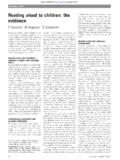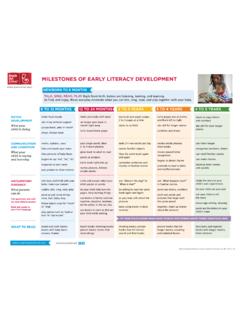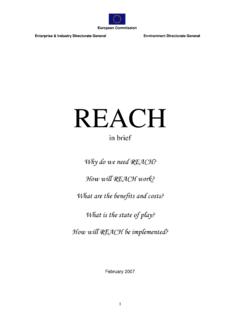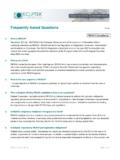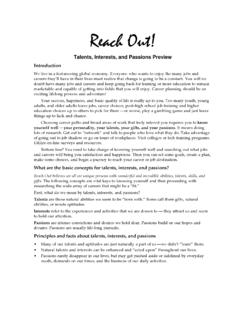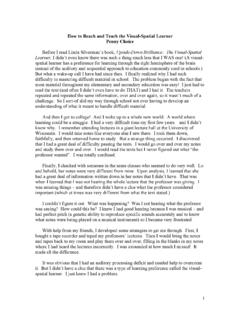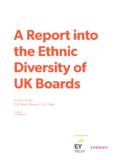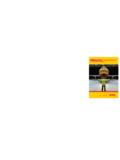Transcription of WHY WE DO THIS: THE IMPORTANCE OF EARLY LITERACY
1 WHY WE DO THIS: THE IMPORTANCE OF EARLY LITERACYWhat do we want parents to do?When we think of the reasons for bringing reach Out andRead into our outpatient clinics, we always think of what wewant parents and children to gain. We want: Parents to enjoy looking at books with their children andunderstand why reading aloud is important. Parents to know how to read aloud effectively, so thatbook time is a positive, pleasant, and affectionate episo-de in the child s day (and in the parent s!), and to have asense of age-appropriate strategies to build the child slanguage abilities and pre-reading skills.
2 Parents to feel supported by the pediatrician in theiraspirations for their children s cognitive and academicsuccess, and ready and able to play their own importantroles in helping that we think of reading readiness, we often think of the skills taught on Sesame Street:letter naming and letter-sound correspondences, phonemic segmentation (the ability tobreak up a word into its component sounds, , /ka-at/), and the acquisition of a sightvocabulary (words that can be read directly without sounding them out). These skills doindeed correlate with successfully learning to read.
3 But there are other, more basic, com-ponents of very EARLY LITERACY . These language skills include vocabulary and what is cal-led decontextualized language, that is, language used to talk about ideas, or aboutevents distant in time or place. Another fundamental component is the sense that prin-ted words are powerful and important, and that books are sources of pleasure and infor-mation. this motivation is crucial, if children are to do the hard work of mastering let-ters and sounds, and it begins very EARLY in life, as children develop spoken language, andas they are exposed to print in EARLY , affectionate, and positive settings that is to say, asthey hear stories read aloud by their is it that we are asking parents to do?
4 To hold young children on their laps, to offerbeautiful age-appropriate books, and to engage their children in some back-and-forthdialogue around the words and the images. Reading routines are repeated sequences ofinteraction between parent and child, in which the parent points out something in thebook, asks the child to give a label or description (What s that? What s that doggydoing?), the child responds, and the parent gives feedback (Right, he s playing with aball!). At its simplest, the routine involves pointing (Parent: Where s the doggy?)
5 , at its13most complex, a prediction or explanation (Parent: Why does that doggy look sad? What s going to happen next? ). Whitehurst has coined the phrase dialogic reading to describe this back-and-forth process. His research shows that dialogic reading is muchmore effective in promoting verbal language development than is regular readingaloud. Note, therefore, that parents who lack LITERACY skills can still be very effective rea-ders to their young can we integrate all this into the well-child visit?For primary care providers, the key is to combine LITERACY guidance with other aspects ofthe exam.
6 To do this well, you want to introduce the book at the beginning of the visit,and use it to build rapport (or distract a fidgety child while taking the history); ideally,you want to use the child s reaction to the book, and any modeling you do for the parent,as part of a developmental assessment. The ROR provider training is designed to helpyou integrate the book into your well-child visit, so that LITERACY promotion becomes partof your standard interaction, assessment, and guidance. To do this , providers will needto be aware of LITERACY -related milestones , understand what book-related skills oneexpects from a six-month-old or a two-year-old.
7 In addition to the curriculum of theprovider training, ROR offers handouts and posters on LITERACY developmental miles-tones, and developmental code cards (available for medical providers through the RORN ational Center or at all trainings) which combine standard developmental milestoneswith LITERACY -related if the parent has difficulty reading?Not all parents will instantly catch on to your LITERACY advice. If parents have not beenread to, it may well feel awkward and uncomfortable. Be aware that a highly prescripti-ve approach ( You need to read every day or your child will be at risk for failure ) mayincrease parental anxiety, and make pleasant, relaxed reading even less likely.
8 Mostparents have the reading skills to manage a simple picture book. But with low LITERACY ,there often comes a belief that books are something unpleasant, difficult, or tension-producing. On the other hand, low-literate parents may be even more motivated thanothers to give their children a healthy start towards LITERACY and we can use that motiva-tion to encourage the parents to read need to be thoroughly familiar with local resources for family LITERACY andadult LITERACY programs, including the availability of local programs, necessary referralsteps, and eligibility requirements.
9 this will allow them to respond to the needs ofparents and families, and to seize the moment whenever a parent s desire to help a childseems to be blocked by the parent s own limited is EARLY LITERACY ?In the past, LITERACY reading and writing and language talking and understanding were viewed as separate cognitive processes, which developed in a set sequence; that is,children learned to understand and then to speak, then, much later, could be taught toread and then to write. As a result, formal LITERACY instruc-tion began in school when children were ready, and littlepedagogic consideration was given to the IMPORTANCE ofchildren s books and reading aloud in the home.
10 EARLY lite-racy is part of a relatively new (1980s) understanding ofhow children develop reading, writing, and language to this understanding, LITERACY : Is a continuous developmental process. Includes listening, speaking, reading, and writing. Begins prior to formal instruction in reading. Develops in real-life settings for real is now understood that LITERACY development beginsearly in life and is very much dependent on environmen-tal influences. In other words, we can look at LITERACY deve-lopment the same way we look at language development.

